最新The-art-of-public-speakingppt课件
The art of public speaking.pptx

Culture and Language Considerations
01
Cultural Norms
Be aware of any cultural norms or tables that might affect your audience's reception of your message Avoid offering language or topics that might be considered taboo
Appropriate Delivery
Appropriate delivery involves speaking at an appropriate space, using modulation in volume and pitch, and maintaining eye contact with the audience The speaker should also vary their tone and space to keep the audience engaged
03
Engaging Content
Engaging content keeps the audience interested and involved It should be relevant, interesting, and tailed to the target audience
Elements of a Good Speech
Demographics and Psychology
Occupational Backgrounds Understanding your audience's expertise can help you connect with them on a personal level and provide relevant examples from their industry
The_art_of_public_speaking[1](1)
](https://img.taocdn.com/s3/m/0844a922ccbff121dd3683ed.png)
was first developed by the ancient Greeks. were taught first by a group of self-styled "sophists" who were known to "make the weaker argument the stronger." Plato and Aristotle developed theories of public speaking in opposition to the Sophists.
18
Public Speaking
a vital means of communication
a way of making your ideas public – of
sharing them with other people and of influencing other people
41% of the 3000 respondents listed "fear of public speaking" as their No.1 fear, while 19% listed "death."
The top 5 fears of people are : 1. Public speaking!!! 2. Heights. 3. Insects and bugs. 4. Financial problems. 5. Deep water.
• What applied skills and basic knowledge are most important for those you will hire with a four-year college diploma?
The-art-of-public-speaking-chapter-1-.2-.3PPT幻灯片课件

McGraw-Hill
© 2007 Stephen E. Lucas. All rights reserved.
Slide 3
Requirements of the course
• Lecture Attendance
McGraw-Hill
© 2007 Stephen E. Lucas. All rights reserved.
Slide 22
Feedback
The messages, usually nonverbal, sent from a listener to a speaker.
•Even meanings attached to gestures for such basic messages as “yes” and “no” are culturally based.
McGraw-Hill
© 2007 Stephen E. Lucas. All rights reserved.
所有资料来源于网络仅供大家参考学习版权归原作者
One C H A P T E R
Art of Public Speaking
McGraw-Hill
Stephen E. Lucas
© 2007 Stephen E. Lucas. All rights reserved.
Slide 2
Learning objectives of the course
McGraw-Hill
© 2007 Stephen E. Lucas. All rights reserved.
Slide 11
The-art-of-public-speakingPPT课件
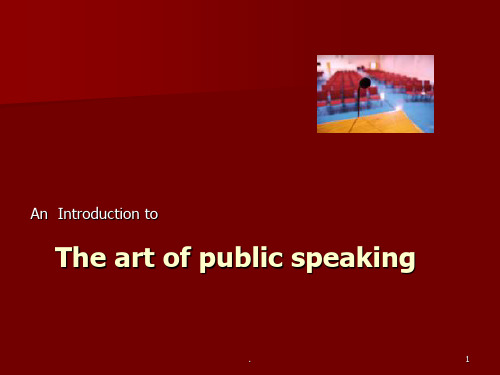
It was not until the 5th century BC that roots of rhetoric were planted for it to become an art form by teachers, called Sophists (wisdom bearer智者/诡辩家)
.
10
What Causes Stage Fright?
inadequate preparation fear of being judged unfamiliarity with the audience or the
environment lack of knowledge about public
speaking feelings of inadequacy fear of the unknown negative past experiences
.
11
Important Understandings About Stage Fright
It is normal. Almost everyone experiences some nervousness about speaking in some situations.
the art, process, or act of effectively
addressing the public to inform,
persuade or entertain them
.
3
History of Public Speaking
The Art of Public Speaking —第十一单元

11.Delivering the Speech What is Good Delivery?Methods of DeliveryReading from a ManuscriptReaing from MemorySpeaking ImpromptuSpeaking ExtemporaneouslyThe Speaker’s V oiceV olumePitchRatePausesV ocal VarietyPronunciationArticulationThe Speaker’s BodyPersonal AppearanceEye ContactGesturesMovementPracticing DeliveryIf you were to record one of Dashan's comedy routines, memorize it word for word,and stand up before your friends to recite ti, would you get the same response Dashan does? Not very likely. And why not? Because you would bot deliver the jokes as Dashan does. Of course, the jokes are basically funny. But Dashan brings something extra to the jokes--his manner of presentation,his vocal inflections, his perfectly timed pauses his facial expressions, his gestures. All these are part of an expert delivery. It would take you years of practice--as it took Dashan--to duplicate his results.This example demonstrates how important delivery can be to any public speaking situation.Even a mediocre speech can be ruined by poor delivery. You cannot make a good speech without having something to say. But having something to say is bot enough. You must also know how to say it.What Is Good Deliver Good delivery does not call attention to itself. It conveys the speaker's ideas clearly, interestingly, and without distracting the audience. Most audiences prefer delivery that combines a certain degree of formality with the best attributes of good conversation--directness, spontaneity, animation, vocal and facial expressiveness, and a lively sense of communication.Speech delivery is an art, not a science.What works for one speakermay not work for another. And what succeeds with today's audience may fail with tomorrow's. You cannot become a skilled speaker just by following a set of rules in a textbook. In the long run, there is no substitute for experience. But take heart! A textbook can give you basic pointers to get you started in the right direction.When you plan your first speech, you should concentrate on such basics as speaking intelligibly, avoiding distracting mannerisms, and feel fairly comfortable in front of an audience, you may find yourself able to control the timing and rhythm of a speech as skillfully as a conductor controls an orchestra.Methods of Deliver There are four basic methods of delivering a speech:(1) reading verbatim from a manuscript;(2) reciting a memorized text; (3) speaking impromptu; and (4) speaking extemporaneously. Let us look at each. REDING FROM A MANUSCRIPTCertain speeches must be delivered word for word, according to a meticulously prepared manuscript. Examples include an engineer's report to a professional meeting or a prime minister's speech at the United Nations. In such situations, absolute accuracy is essential. Every word of the speech will be analyzed by the press, by colleagues,Perhaps by enemies. In the case of the prime minister, a misstated phrase could cause an international incident.Although it looks easy, delivering a speech from manuscript requires great skill. Some people do it well. Others ruin it every time. Instead of sounding vibrant and conversational, they march through the speech without even glancing at their audience. In short, they come across as reading to their listeners, rather than as talking with them.If you are in a situation where you must speak from a manuscript, practice aloud to make sure the speech sounds natural. Work on establishing eye contact with your listeners. Be certain the final manuscript is sincerity that you would if you were speaking extemporaneously.RECITING FROM MEMORYPresenting a speech entirely from memory is often required of speakers when they make brief presentations such as toasts, congratulatory remarks, acceptance speeches, introductions, and the like.Speaking from memory is also required for prepared speeches in competitions such as the CCTV Cup and the 21st Century Cup. If you are giving a speech of this kind, be sure to memorize it so thoroughly that you will be able to concentrate on communicating with the audience, rather than on trying to remember the words.SPEAKING IMPROMPTUAn impromptu speech is delivered with little or no immediate preparation.Few people choose to speak impromptu, but sometimes itcannot be avoided.In face, many of the speeches you give in life will be impromptu. You might be called on suddenly to" say a few words, " or, in the course of a class discussion, business meeting, or committee report, you might want to respond to a previous speaker.When such situations arise, don't panic.If you are in a meeting or discussion, pay close attention to what the other speakers say.Take notes of major points with which you agree or disagree. In the process, you will automatically begin to formulate what you will say when it is your turn to speak.Whenever you are responding to a previous speaker, try to present your speech in four simple steps:First, state the point you are answering.Second, state the point you wish to make. Third, support your point with evidence and reasoning. Fourth, summarize your point. This four-step method will help you organize your thoughts quickly and clearly.Once you begin speaking, maintain strong eye contact with the audience. Help the audience keep track of your ideas with signposts such as "My first point si...;second, we can see that...; in conclusion, I would like to say..."If you have had time to prepare, you will come across as organized and confident.As with other kinds of public speaking, the best way to become a better impromptu speaker is to practice. You can do this on your own.Simply choose a topic on which you are already well informed, and gibe a one-or two-minute impromptu talk on some aspect of that topic. Any topic will do, no matter how serious or frivolous it may be.You don't even need an audience --you can speak to an empty room. Better yer, speak to a digital recorder and play it back to hear how you sound. The purpose is to gain experience in pulling your ideas together quickly and starting them succinctly.SPEAKING EXTEMPORANEOUSLYIn popular usage," extemporaneous" means the same as "impromptu." But technically the two are different. Unlike an impromptu speech, which is delivered off-the-cuff,an extemporaneous speech is carefully prepared and practiced in advance.In presenting the speech, the extemporaneous speech is carefully prepared and practiced in advance. In presenting the speech, the extemporaneous speaker uses only a set of brief notes or a speaking outline to jog the memory. The exact wording is chosen at the moment of delivery.The extemporaneous method has several advantages.It gives more precise control over thought and language than impromptu speaking; it offers greater spontaneity and directness than speaking from memory or from a full manuscript; and it is adaptable to a wide range of situations.It also encourages the conversational quality audiences look for in speech delivery."Conversational quality" means that no matter how many timesa speech has been rehearsed, it still sounds spontaneous.Later in this chapter, we'll look at a step- by- step program for practicing your extemporaneous delivery.The Speaker's VoiceA golden voice is an asset for any public speaker, but it is not a necessity.Some of the most famous speakers in history have had undistinguished voices.Abraham Lincoln had a harsh and penetrating voice ; Winston Churchill suffered from a slight lisp and an awkward stammer. Like them, you can overcome natural disadvantages and use your voice to the best effect. Lincoln and Churchill learned to control their voices. You can do the same thing.The aspects of voice you should work to control are volume, pitch, rate, pauses, variety, pronunciation, and articulation.VOLUMEAt one time, a powerful voice was essential for an orator.Today, electronic amplification allows even a soft-spoken person to be heard in any setting.Whether you speak with or without a microphone, be sure to adjust our voice to the acoustics of the room, the size of the audience , and the level of background noise.If you speak too loudly, your listeners will think you boorish. If you speak too softly, they will not understand you.Remember that your own voice always sounds louder to you than to alistener. Soon after beginning your speech, glance at the people farthest away from you.If they look puzzled, ate leaning forward in their seats, or ate otherwise straining to hear, you need to talk louder.PITCHPitch is the highness or lowness of the speaker's voice.Changes in pitch are known as inflections. They give your voice luster, warmth, and vitality.Inflections reveal whether you are asking a question or making a statement, whether you are being sincere or sarcastic. Your inflections can also make you sound happy or sad, angry or pleased, dynamic or listless, tense or relaxed.Few people speak in an absolute monotone, with no variation whatever in pitch, but many fall into repetitious pitch patterns that are just as hypnotic. You can guard against this by recording your speeches as you practice them. If all your sentences end on the same inflection--either upward or downward--word on your pitch patterns to fit the meaning of your words .RATERate refers to the speed at which a person speaks. Native speakers of English usually talk at a rate between 120 and 150 words per minute, be there is no uniform rate for effective speechmaking.The best rate depends on several things --the vocal attributes of the speaker, the mood she or he is trying to create, the composition of the audience, and thenature of the occasion.Two obvious faults to avoid are speaking so slowly that your listeners become bored or so quickly that they lose track of your ideas. The key in both cases is to become aware of the problem and then to concentrate on solving it .Use a digital recorder to check how fast you speak. Pay special attention to rate when practicing your speech, and note where you need to slow down or speed up. Finally, be sure to include reminders about rate on your speaking outline so you won’t forget to make the adjustments when you present your speech.PAUSESLearning how and when to pause is a major challenge for most beginning speakers. As you gain more poise and confidence, however, you will discover how useful the pause can be. It can signal the end of a thought unit, give an idea time to sink in, and lend dramatic impact to a statement. “The right word may be effective,” said Mark Twain, “but no word was ever as effective as a rightly timed pause.”Developing a keen sense of timing is partly a matter of common sense, partly a matter of experience. You will not always get your pauses just right at first, but keep trying. Listen to accomplished speakers to see how they use pauses to modulate their rate and rhythm. Work on pauses when you practice your speeches.When you pause, make sure you do so at the end of thought units andnot in the middle. Most important, do not fill the silence with “um,” “er,” or “well.” These vocalized pauses are distracting to listeners and can damage a speaker’s credibility.VOCAL V ARIETYJust as variety is the spice of life, so is it the spice of public speaking.A flat, listless, unchanging voice is just as deadly to speechmaking as a flat, listless, unchanging routine is to daily life. When giving a speech, you should vary the rate, pitch, and volume of your voice to communicate your ideas and feelings.As you practice your speeches, record them to hear how they sound. Try them out on members of your family, a friend, or a roommate. Practice the vocal variety exercise at the end of this chapter. Above all, approach every speech as an opportunity to share ideas that are important to you. Your sense of conviction and your desire to communicate will give your voice the same spark it has in spontaneous conversation. PRONUNCIATIONPronunciation poses a challenge for anyone who presents speeches in a second language. Although native speakers of English are very tolerant of pronunciation errors by nonnative speakers in spontaneous conversation, they expect a higher degree of accuracy in formal speeches. As you work on your speeches, pay special attention to words that are difficult for you to pronounce and practice them until you can say themcorrectly. If you have any doubts about particular words, check an online dictionary that includes audio pronunciation.ARTICULATIONArticulation and pronunciation are not identical. Sloppy articulation is the failure to form particular speech sounds crisply and distinctly. Most of the time, poor articulation is caused by laziness—by failing to manipulate the lips, tongue, jaw, and soft palate so as to produce speech sounds clearly and precisely.One of the most common articulation errors by English speakers, native and nonnative alike, comes form the careless blending of two short words—such as saying “lemme” instead of “let me,” “gonna” instead of “going to,” and “didja” instead of “did you.” Here are some other common errors in articulation you should work to avoid:Word Misarticulationought to ottadon’t know dunnohave to haftawant to wannawill you wilyaThe Speaker’s Body Posture.facial expression,gestures,eye contact-all effect the way listenersrespond to a speaker.How we use these and other body motions to communicate is the subject of a fascinating area of study called kinesics.One of its founders,Ray Birdwhistell,estimated that more than 700,000 physical signals can be sent through bodily movement.Studies have shown that these signals have a significant impact on the meaning communicated by speakers.Research has also confirmed what the Greek historian Herodotus observed more than 2400 years ago:”People trust their ears less than their eyes.”When aspeaker’s body language is inconsistent with his or her words,listeners often believe the body language rather the words.Here are the major aspects of physical action that will affect the outcome of your speeches.PERSONAL APPEARANCEA number of studies have confirmed that personal appearance plays an important role in speechmaking.Listeners always see you before they hear you,Just asyou adapt your language to the audience and the occasin,so should you dress and groom appropriately.Although the force of your speech can sometimes overcome a poor impression created by personal appearance,the odds are against it.Regardless of the speaking situation,you should try to evoke a favorable first impression.EYE CONTACTLike many elements of communication, eye contact is influenced bycultural background. When engaged in conversation, Arabs, Latin Americans, and Southern Europeans tend to look directly at the person with whom they are talking. People from some Asian countries and parts of Africa tend to engage in less eye contact.When it comes to public speaking, there is wide agreement across cultures on the importance of some degree of eye contact. In most circumstances, one of the quickest ways to establish a communicative bond with your listeners is to look at them personally and pleasantly. Avoiding their gaze is one of the surest ways to lose them.When addressing a small audience, you can usually look briefly from one person to another. For a larger group, you will probably scan the audience rather than trying to engage the eyes of each person individually. No matter what the size of your audience, you want your eyes to convey confidence, sincerity, and conviction. They should say, “I am pleased to be able to talk with you. I believe deeply in what I am saying, and I want you to believe init too.”GESTURESFew aspects of delivery cause beginning speakers more anguish than deciding what to do with their hands. Even people who use their hands expressively in everyday conversation seem to regard them as awkward appendages when speaking before an audience.Adroit gestures can add to the impact of a speech, but effectivespeakers do not need a vast repertoire of gestures. Some accomplished speakers gesture frequently; others, hardly at all. The primary rule is this: Whatever gestures you make should not distract from your message. They should appear natural and spontaneous, help clarify or reinforce your ideas, and be suited to the audience and occasion.Gesturing tends to work itself out as you acquire experience and confidence. For now, make sure your hands do not upstage your ideas. Avoid flailing them about, wringing them together, or sticking them in your pockets. Once you have eliminated these distractions, forget about your hands. Think about communicating with your listeners, and your gestures will take care of themselves-just as they do in conversation. MOVEMENTNovice speakers are often unsure what to do with their body while giving a speech. Some space back and forth across the podium or repeatedly shift their weight from one foot to another. Such quirks usually stem from nervousness or inexperience. Once they are pointed out to you, concentrate on eliminating them in later speeches.As important as how you act during the speech is what you do just before you begin and after you finish. As you rise to speak, try to appear calm, poised, and confident, despite the butterflies in your stomach. When you reach the lectern, don’t lean on it, and don’t rush into your speech. Give yourself time to get set. Arrange your notes just the way youwant them. Stand quietly as you wait to make sure the audience is paying attention. Establish eye contact with your listeners. Then-and only then-should you start to talk.When you reach the end of your speech, maintain eye contact for a few moments after you stop talking. Unless you are staying at the lectern to answer questions, collect your notes and return to your seat. As you do so, maintain your cool, collected demeanor. Whatever you do, don’t start to gather your notes before you finish talking; and don’t cap off your speech with a huge sigh of relief or some remark like, “Whew! Am I glad that’s over! ”When practicing your speeches, spend a little time rehearing how you will behave at the beginning and at the end. It is one of the easiest-and one of the most effective-things you can do to improve your image with an audience.As experienced speakers know, you need to practice a speech thoroughlybefore delivering it. If possible, try to rehearse under conditions as close as possible to those you will face during the speech itself.Practicing Delivery Popular wisdom promises that practice makes perfect. This is true, but only if we practice properly .You will do little to improve your speech delivery unless you practice the right things in the right ways. Here is a five-step method that has worked well for many speakers:1. Go through your preparation outline aloud to check how it translates into spoken discourse. Is it too long? Too short? Are the main points clear when you speak them?Do the introduction and conclusion come across well? As you answer these questions, revise the speech as needed.2. Prepare your speaking outline. In doing so, be sure to follow the guidelines in Chapter e the same visual framework as in preparation outline. Make sure the speaking outline is easy to read at a glance. Give yourself cues the outline for delivering the speech.3. Practice the speech aloud several times using only the speaking outline. Be sure to “talk through” all examples and to recite in full all quotations and statistics. If your speech includes visual aids, use them as you practice. The first couple of times, you will probably forget something or make a mistake, but don’t worry. Keep going and complete the speech as well as you can. Concentrate on gaining control of the ideas;don’t try to learn the speech word for word. After a few tries, you should be able to get through the speech extemporaneously with surprising ease. Checklist DeliveryYES NO( ) ( ) 1. Do I understand the four methods of speech delivery? ( ) ( ) 2.Can I concentrate on communicating with my audience rather than on trying to remember what I want to say? ( ) ( ) 3.Have I recorded my speech when rehearing to check volume, rate, pitch, and vocal variety?( ) ( ) 4.Have I eliminated vocalized pauses from my speech? ( ) ( ) 5.Have I practiced the pronunciation and articulation of all challenging words?( ) ( ) 6.Have I dressed properly for the audience and the occasion? ( ) ( ) 7.Have I rehearsed how I will act at the beginning and end of my speech to create a favorable impression?( ) ( ) 8.Have I identified distracting mannerisms that I should avoid during the speech?( ) ( ) 9.Have I gone over all aspects of the speech, including visual aids, in my practice sessions?( ) ( ) 10.Have I practiced the timing of my speech so I can complete it in the allotted time?( ) ( ) 11.Have I followed the five-step method of practicingdelivery explained in this chapter?( ) ( ) 12.Have I started practicing early enough that I will be fully prepared and confident on speech day?4. Now begin to polish and refine your delivery. Practice the speech in front of a mirror to check for eye contact and distracting mannerisms. Record the speech to gauge volume, pitch, rate, pauses, and vocal variety. Most important, try it out on friends, roommates, family members-anyone who will listen and give you an honest appraisal. Since your speech is designed for people rather than for mirrors or records, you need to find out ahead of time how it goes over with people.5. Finally, give your speech a dress rehearsal under conditions as close as possible to those you will face on speech day. Some students like to try the speech a couple of times in an empty classroom the day before the speech is due. Professional speakers usually familiarize themselves with the room in which they will be speaking. No matter where you hold your last practice session, you should leave it feeling confidentand looking forward to addressing your audience.If this or any practice method is to work, you must start early. Don’t wait until the night before your speech to begin working on delivery. A single practice session—no matter how long—is rarely enough. Allow yourself plenty of time to gain command of the speech and its presentation.Summary: Speech delivery involves using the voice and body to convey the message expressed by a speaker’s words. Rather than calling attention to itself, effective delivery conveys the speaker’s ideas c learly, engagingly, and without distracting the audience.There are four basic methods of delivering a speech: reading verbatim form a manuscript, reciting a memorized text, speaking impromptu, and speaking extemporaneously.To use your voice effectively, you should work on controlling your volume, pitch, rate, pauses, vocal variety, pronunciation, and articulation. V olume is the relative loudness of your voice, and pitch is the relative highness or lowness. Rate refers to the speed at which you talk. Pauses, when carefully timed, can add impact to your speech, but you should avoid vocalized pauses (“er,”“well,”and the like ) .V ocal variety refers to changes in volume, pitch, rate, and pauses and is crucial to making your voice lively and engaging. For pubic speaking, you should be sure to pronounce words correctly and to articulate them distinctly.Posture, personal appearance, facial expression, gestures, and eye contact also affect the way listeners respond to speakers. Dress and groom appropriately, use gestures and bodily movement to enhance your message, and make eye contact with your listeners.You should practice all these aspects of delivery along with the wordsof your speech. Start your practice sessions early so you will have ample time to polish your presentation..Key terms: Manuscript speech (148) pause (151) impromptu speech (148) V ocalized pause (151) extemporaneous speech (149)V ocal variety (151) conversational quality (149)Pronunciation (152) volume (150) articulation (152) Pitch (150) kinesics (153) inflections (150) Eye contact (154) rate (150) gestures (154)Exercises for thinking and speaking 1.An excellent way to improve your variety is to read aloud selectionsfrom poetry that require emphasis and feeling. Choose an English-language poem and practice reading aloud. Use your voice to make the poem come alive. Vary your volume, rate, and pitch. Find the appropriate places for pauses. Underline the key words or phrases you think should be stressed. Use inflections for emphasis and meaning.If possible, practice reading the selection into a digital recorder. Listen to the playback. If you are not satisfied with what you hear, practice the selection some more and record it again. Finally, present the poem in class to receive feedback from your classmates and instructor.2.Watch a 10-minute segment of a television drama with the sound off.What do the characters say with their dress, gestures, facial expressions, and the like? Do the same with a television comedy. How do the nonverbal messages in the two shows differ? Be prepared to report your observation in class.3.attend an English-language speech on campus. Prepared a brief reporton the speaker’s delivery. In your report analyze the speaker’s volume, pitch, rate, pauses, vocal variety, pronunciation, and articulation. Also evaluate the speaker’s personal appearance, bodily action, gestures, and eye contact. Finally, note two techniques of delivery used by the speaker that you might want to try in your next speech.4.present a 1-2 minute report to your class analyzing the delivery of twoof the speaker included on the CD-ROM for this chapter (videos11.1-11.6)Public Speaking in Your Career After receiving your master’s de gree, you accepted a job in the English department at a local university, where you have been teaching public speaking. Now you have been invited to attend a provincial conference on English public speaking instruction, at which you will present a paper on “The Three Most Important Elements of Speech Delivery .” Prepare a 2-minute summary explaining the elements of delivery that you believe are most important, and why.。
The-art-of-public-speaking-chapter-1-.2-.3

•Not only do words change from language to language, but so do ways of thinking and of seeing the world.
tic expression (song, poetry, play) persuasion advising inspiring argumentation
McGraw-Hill
© 2007 Stephen E. Lucas. All rights reserved.
Slide 7
PS & intercultural communicative competence
Slide 9
Cultural Diversity and Public Speaking
Diversity and multiculturalism are such basic facts of life that can play a role in almost any speech you give:
2. If there is a language difference between you and your audience, avoid any words or phrases that might cause misunderstanding.
3. When delivering your speech, be alert to feedback that might indicate the audience is having trouble grasping your ideas.
9-The-art-of-public-Speaking-公共演讲的艺术
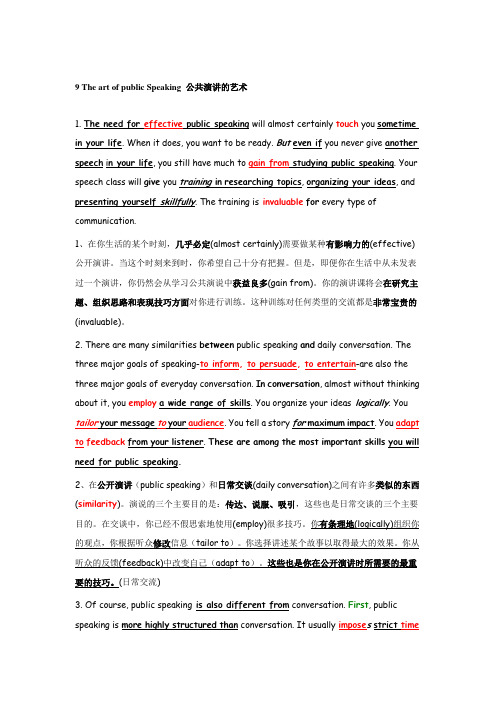
9 The art of public Speaking 公共演讲的艺术1. The need for effective public speaking will almost certainly touch you sometime in your life. When it does, you want to be ready. But even if you never give another speech i n your life, you still have much to gain from studying public speaking. Your speech class will give you training in researching topics, organizing your ideas, and presenting yourself skillfully. The training is invaluable for every type of communication.1、在你生活的某个时刻,几乎必定(almost certainly)需要做某种有影响力的(effective)公开演讲。
当这个时刻来到时,你希望自己十分有把握。
但是,即便你在生活中从未发表过一个演讲,你仍然会从学习公共演说中获益良多(gain from)。
你的演讲课将会在研究主题、组织思路和表现技巧方面对你进行训练。
这种训练对任何类型的交流都是非常宝贵的(invaluable)。
2. There are many similarities between public speaking and daily conversation. The three major goals of speaking-to inform, to persuade, to entertain-are also the three major goals of everyday conversation. In conversation, almost without thinking about it, you employ a wide range of skills. You organize your ideas logically. You tailor your message to your audience. You tell a story for maximum impact. You adapt to feedback from your listener. These are among the most important skills you will need for public speaking.2、在公开演讲(public speaking)和日常交谈(daily conversation)之间有许多类似的东西(similarity)。
theartofpublicspeakingchapter专题培训课件

• Clustering (People, places, things, events, processes, concepts, problems, plans/policies)
• Internet Search (Connect to a subject
based search engine such as
• When your general purpose is to inform, you act as a teacher or lecturer. Primary goal: to convey information clearly, accurately, and interestingly.
theartofp ublicspeak C H A P T E R ingchapte
r4
McGraw-Hill
Stephen E. Lucas
© 2007 Stephen E. Lucas. All rights reserved.
Slide 2
Learning objective:
• how to select an appropriate topic and limit it so that you can cover it in the allotted time
• Think about special knowledge or expertise you may have acquired.
McGraw-Hill
© 2007 Stephen E. Lucas. All rights reserved.
Slide 6
Topics You Want to Know More About
the-art-of-public-speaking-chapter9ppt课件
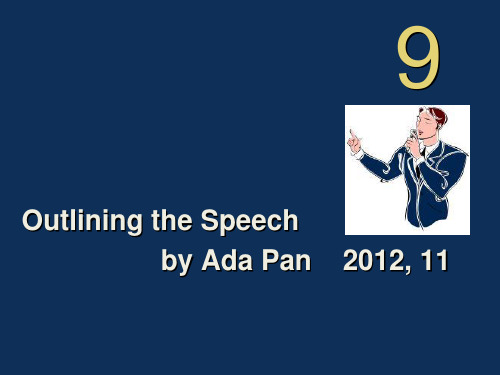
LCCC ENG 111
Instructor
9
Tips for Preparing a Preparation Outline
• Use complete sentences • Label the introduction, body, conclusion and
connectives • Use a consistent pattern of symbols and
The speaking outline: a condensed form of the preparation outline
used to help the speaker remember his or her ideas as they speak.
The Preparation Outline
Outline Brings Together All Of
Supporting Points – in full declarative The Major
sentences. Conclusion Bibliography
Elements Of The Speech
KimAlyse Popkave, M.Ed., CMI, CPPC
indentation • State the main points and submain points in
full sentences • Label transitions, internal summarizes and
internal previews
The Speaking Outline
Tips for Preparing the Speaking Outline
• Follow the visual framework used in the preparation outline
the art of public speaking Chapter informativespe
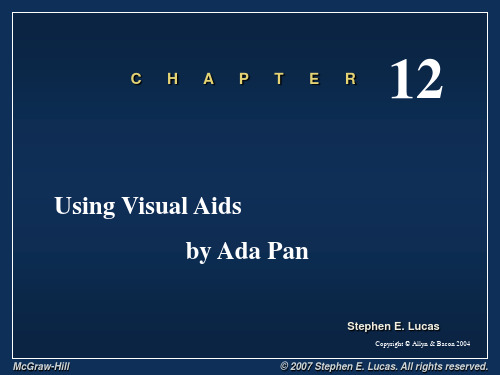
Slide 3
Types of Presentational Aids
• Objects • Graphics
– Picture – Diagram – Line Graph – Bar Graph – Pie Graph – Chart – Map
McGraw-Hill
© 2007 Stephen E. Lucas. All rights reserved.
12 C H A P T E R
Using Visual Aids by Ada Pan
McGraw-Hill
Stephen E. Lucas
Copyright © Allyn & Bacon 2004
© 2007 Stephen E. Lucas. All rights reserved.
Slide 2Slide 5Designing Presentational Aids
• Focus • Layout • Highlighting • Fonts • Color and art
McGraw-Hill
© 2007 Stephen E. Lucas. All rights reserved.
Slide 6
McGraw-Hill
© 2007 Stephen E. Lucas. All rights reserved.
Slide 9
Tips for Visual Aids
• 1. display visual aids where listeners can see them • 2. explain visual aids • 3. avoid passing visual aids among the audience • 4. display visual aids only while discussing them • 5. talk to your audience , not to your aids • 6. check the room and equipment • 7. develop a backup plan
Chapter 1-THE ART OF PUBLIC SPEAKING
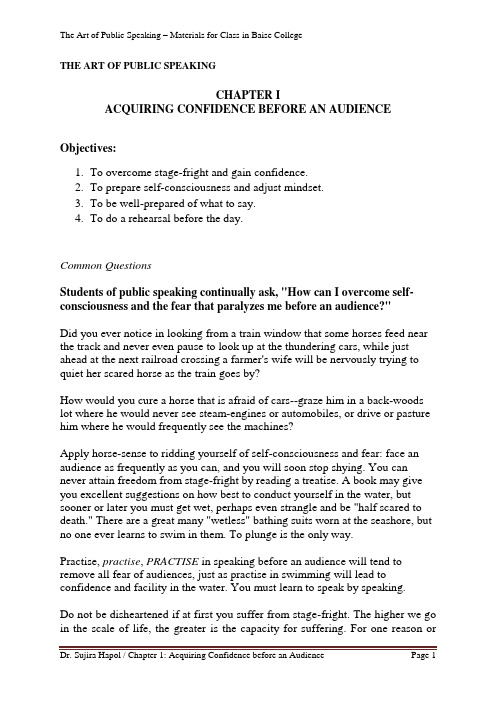
THE ART OF PUBLIC SPEAKINGCHAPTER IACQUIRING CONFIDENCE BEFORE AN AUDIENCEObjectives:1.To overcome stage-fright and gain confidence.2.To prepare self-consciousness and adjust mindset.3.To be well-prepared of what to say.4.To do a rehearsal before the day.Common QuestionsStudents of public speaking continually ask, "How can I overcome self-consciousness and the fear that paralyzes me before an audience?"Did you ever notice in looking from a train window that some horses feed near the track and never even pause to look up at the thundering cars, while just ahead at the next railroad crossing a farmer's wife will be nervously trying to quiet her scared horse as the train goes by?How would you cure a horse that is afraid of cars--graze him in a back-woods lot where he would never see steam-engines or automobiles, or drive or pasture him where he would frequently see the machines?Apply horse-sense to ridding yourself of self-consciousness and fear: face an audience as frequently as you can, and you will soon stop shying. You can never attain freedom from stage-fright by reading a treatise. A book may give you excellent suggestions on how best to conduct yourself in the water, but sooner or later you must get wet, perhaps even strangle and be "half scared to death." There are a great many "wetless" bathing suits worn at the seashore, but no one ever learns to swim in them. To plunge is the only way.Practise, practise, PRACTISE in speaking before an audience will tend to remove all fear of audiences, just as practise in swimming will lead to confidence and facility in the water. You must learn to speak by speaking.Do not be disheartened if at first you suffer from stage-fright. The higher we go in the scale of life, the greater is the capacity for suffering. For one reason oranother, some master-speakers never entirely overcome stage-fright, but it will pay you to spare no pains to conquer it. Many great speakers initially failed in their first appearance and had to take their seat without finishing their speech because they were too nervous.Be Absorbed by Your SubjectIf you feel deeply about your subject you will be able to think of little else. Concentration is a process of distraction from less important matters. Don’t think anything else once you are upon the platform, so center your interest on what you are about to say--fill your mind with your speech-material and then it will drive out your unsubstantial fears.Have Something to SayThe trouble with many speakers is that they go before an audience with their minds a blank. It is not enough to be absorbed by your subject--to acquire self-confidence you must have something in which to be confident. If you go before an audience without any preparation, or previous knowledge of your subject, you ought to be self-conscious--you ought to be ashamed to steal the time of your audience. Prepare yourself. Know what you are going to talk about, and, in general, how you are going to say it. Have the first few sentences worked out completely so that you may not be troubled in the beginning to find words. Know your subject better than your hearers know it, and you have nothing to fear.Assume Mastery Over Your AudienceIn public speech, as in electricity, there is a positive and a negative force. Either you or your audience is going to possess the positive factor. If you assume the negative you are sure to be negative. Assuming a virtue or a vice vitalizes it. Summon all your power of self-direction, and remember that though your audience is infinitely more important than you, the truth is more important than both of you, because it is eternal. Be courageous. BE courageous--it lies within you to be what you will. MAKE yourself be calm and confident.Concluding HintsDo not make haste to begin--haste shows lack of control. Do not apologize. It ought not to be necessary; and if it is, it will not help. Go straight ahead.Take a deep breath, relax, and begin in a quiet conversational tone as though you were speaking to one large friend. To stand before an audience and make them think your thoughts after you is one of the greatest pleasures you can ever know.EXERCISE: Group Task (5 students in one group)1.Write out a two-minute speech on "Confidence and Cowardice."2.Give a three-minute talk on "Stage-Fright," including some examples.3.Choose a representative to give a speech.4.Do a VDO shooting for each individual task.5.Some comments shared by the class after VDO playing.LEARNING-OUTCOME EXPECTATION: The class will finally1.get the ideas of stopping the stage-fear.2.gain the concept of preparation.3.give comments for the speech presentations.4.assess the speech contents and presentations5.apply for each own situation in the real life._____________________________________________________________ ReferencesCarnegie, D. & Esenwein, J.B. (1915). The Art of Public Speaking. MA: The Home Correspondence School.. Accessible on 2.03.2011 at 19.32 hrs.。
The Art of Public Speaking —第十三单元
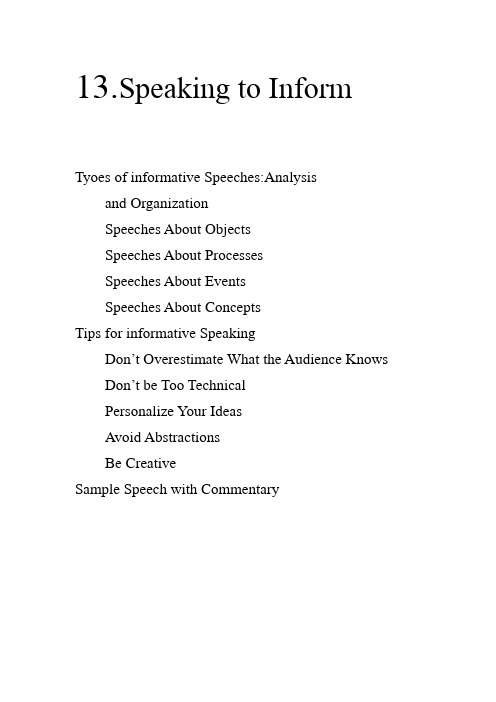
13.Speaking to InformTyoes of informative Speeches:Analysisand OrganizationSpeeches About ObjectsSpeeches About ProcessesSpeeches About EventsSpeeches About ConceptsTips for informative SpeakingDon’t Overestimate What the Audience Knows Don’t be Too TechnicalPersonalize Your IdeasAvoid AbstractionsBe CreativeSample Speech with CommentaryPublic speaking to inform occurs in a wide range of everyday situation: the business manager explaining next year’s budget; the architect reviewing plans for a new building; the tour guide showing historical sites; the scientist presenting a paper at a conference; the teacher in a classroom. There are endless situation in which people need to inform others.In one survey, college student were asked to rank the speech skills most important to their jobs. They ranked informative speaking number one. In another survey, 62 percent of responders said they used informative speaking “almost constantly,” competence in this form of communication will be valuable throughout your life.When you speak to inform, your aim is to convey knowledge and understanding ----not to advocate a cause. Your speech will be judged in light of three general criteria:Is the information communicated accurately?Is the information communicated clearly?Is the information made meaningful and interesting to audience?In this chapter, we will look at four types of informative speeches and the basic principles of informative speaking. Along the way, we will apply various general principles discussed in previous chapters.Types of iInformative Speeches: Analysis and Organization There are many ways to classify informative speeches, here we focus onspeeches about objects, speeches about processes, speeches about events, and speeches about concepts.SPEECHES ABOUT OBJECTSAs the word is used here, “object” include everything that is visible, tangible, and stable in form. Objects may have moving parts or be alive; they may include places, structures, animals, even people. Here are examples for speeches about objects:Gobi Desert computersStock market Sichuan masksXiang embroidery pandaYou will not have enough time to tell your classmates everything about any of these subjects. Instead, you will choose a specific purpose that focuses on one aspect of your subject. Working from the topics presented above, the following are examples of specific purpose statement for informative speeches about objects:To inform my audience about geological features of Gobi Desert.To inform my audience about the latest developments in computer technology.To inform my audience about the craftsmanship of Xiang embroidery.Notice how precise these statements are. As we saw in Chapter 4, you should select a specific purpose that is not too broad to achieve in the allotted time. “To inform my audience about Zhang Mengfu” is far toogeneral for a classroom speech. “To inform my audience about Zhang Mengfu’s contributions to landscape painting” is more precise and is a purpose you could reasonably hope to achieve in a brief talk.If your specific purpose is to explain the history or evolution of your subject, you will put your speech in chronological order. For example: Specific purpose: To inform my audience about the poetic career of DuFu.Central idea: Judged by some experts to be the world’s greatest poet,Du Fu expressed the people’s spirit during atumultuous period in Chinese history.Main point: I. Du Fu was greatly influenced by his friendship withLi Bai during the 740s.II.Du Fu blossomed as a poet during the 750s despitegreat turmoil in his personal life.III.Du Fu reached a peak of creativity during his yearsin Chengdu from 759 to 765.IV.Du Fu contributed to write works of lastingimportance until his death in 770.If your specific purpose is to describe the main features of your subject, you may organize your speech in spatial order:Specific purpose: To inform my audience about the design of the EiffelTower.Central idea: The Eiffel Tower is divided into three sections, eachwith its own functions.Main point: I. The lowest section of the tower contains the entrance,a gift shop, and a restaurant.II.The middle section of the tower consists of stairs andelevators that lead to the top.III.The top section of the tower includes an observationdeck with a spectacular view of Paris.As often as not, you will find that speeches about objects fall into topical order. For example:Specific purpose: To inform my audience about the four majorelements of a Japanese garden.Central Idea: The four mahor elements of a Japanese gardenare stones,sand,water, and plants.Main Points: Ⅰ.The first element of a Japanese garden isstones,which symbolizes the sea or other vastareas.Ⅱ.The second element of a Japanese garden issand, which symbolizes the sea or other vastareas.Ⅲ. The third element of a Japanese garden iswater,which symbolizes cleansing andpurity.Ⅳ.The fourth element of a Japanese garden isplants,which symbolizes life and thechant:ing seasons.No matter which organizational method you use-chronological, spatial, or topical-be sure to follow the guidelines discussed in Chapter 7: (1) limit the number of main points; (2) keep main points separate; (3) try to use the same pattern of wording for all main points; (4) balance the amount of time devoted to each main point.SPEECHES ABOUT PROCESSESA process k a systematic series of actions that leads to a specific result or product. Speeches about processes explain how something is made, how something is done, or how something works. Here are examples of specific purpose statements for speeches about processes: To inform my audience how typhoons developTo mform my audience how to wnte an effective job resumeTo inform my audience how to perform Tai ChiAs these examples suggest. there are two kinds of informative speeches ahout processes. One kind explains a process so that listeners will understand it better .Your goal is to have your audience know the steps of the process and how tbey relate to one another. if your specific purpose is "To inform my audience how nuclear, power plants work," youwill explain the basic structure and mechanisms of a nuclear power plant.You will not instruct your listeners on how they can operate a nuclear power plant.A second kind of speech explains a process so listeners will be better able to perform the process themselves .Your goal in this kind of speech is to have the audience learn a skill .Suppose your specific purpose is "To inform my audience how to take pictures like a professional photographer.” You will present photographic techniques and you’re your listeners how they can use them.Both kmds of speeches about processes may require visual aids. At the very least, you should prepare a chart outlining the steps or techniques of your process in some cases you will need to demonstrate the steps or techniques by performing them in front of your audience. (If you are using visual aids of any kind, be sure to review Chapter 12.)When informing about a process. you will usually arrange your speech in chronological order, explaining the process step by step from beginning to end. For example:Specific Purpose: To inform my audience about the major rituals of a traditional Bengali wedding in India.Centrai idea: A traditional Bengali wedding consists of series of rituals that take place before, during, and after the wedding ceremony. Main Poins: Ⅰ.Pre-wedding rituals include giving gifts to thebride and groom and dressing the bride intraditional fashion.Ⅱ.Rituals during the ceremony include an exchangeof garlands between the bride and groom, thechannng of mantras, and the giving away of thebride by her uncle.Ⅲ.Post-wedding rituals a celebration at the homeof the bride’s family, a reception at the home ofmantras,and the formal exit of the bride andgroom.Sometimes, rather than moving through a process step by step, you will focus on the major principles or techniques involved in performing the process. Then you will organize your speech in topical order. Each main point will deal with a separate principle or technique. For example: Specific Purpose: To inform my audience of the common methods usedby stage magicians to perform their tricks.Central idcra: Stage magicians use two common metheds to performtheir tricks-mechanical devices and sleight of hand. Main Points: Ⅰ.Many magic tricks rely on mechanical devices thatmay require little ,skill by the magician.Ⅱ.Other magic tricks depend on the magician’s skill infooling people by sleight-of-hand manipulationConcise organization is especially important in speeches about processes. You must make sure each step is clear and easy to follow. If your process has more than four or five steps, group the steps into units to limit the number of main pointsSPEECHES ABOUT EVENTSThe Random House Dictionary defines an event as “anything that happens or is regarded as happening.”By this definition, the following are examples of suitable subjects for informative speeches about events: insomnia(失眠) marriageWorld Cup Battle of Red Cliffs(赤壁之战)tsunami(海啸) cyber crime(网络犯罪) As usual, you will need to narrow your focus and pick a specific purpose you can accomplish in the allotted(分配的) time. Here are examples of specific purpose statements for informative speeches about events:To inform my audience about healthy cures for insomniaTo inform my audience about events at the Battle of Red CliffsTo inform my audience about the major types of cyber crimeThere are many ways to discuss events. If your specific purpose is to recount the history of an event, you will organize your speech in chronological(按时间顺序) order, relating the incidents one after another in the order they occurred. For example:Specific Purpose: To inform my audience about the history of theParalympics(残奥会,原为脊髓病患者举办的运动会)Central Idea: Olympic-style games for athletes with physicaldisabilities have made great strides(进步) since thefirst competition more than 60 years ago.Main Points: Ⅰ. What would eventually become the Paralympicsbegan in 1948 with a sports competition in GreatBritain involving World War Ⅱveterans(退伍军人) with spinal cord(脊髓) injuries.Ⅱ. In 1952, the event expanded when athletes fromthe Netherlands(荷兰) took part.Ⅲ. The first official Paralympic Games forinternational athletes took place in Rome in1960.Ⅳ. In 2001, an agreement was signed officiallyholding the Paralympic Games alongside thesummer and winter Olympic Games.You can approach an event from almost any angle or combination of angles-features, origins, implications, benefits, future development, and so forth. In such cases, you will put your speech together in topical order, making sure that your main points subdivide(细分) the subjectlogically(合乎逻辑地) and consistently(一致地). For instance:Specific Purpose: To inform my audience about the four roles in PekingOpera.Central Idea: The four major roles in Peking Opera are Sheng, Dan,Jing, and Chou.Main Point: Ⅰ. Sheng is the primary male role.Ⅱ. Dan refers to any female role.Ⅲ. Jing is a painted-face male role.Ⅳ. Chou is a male clown role.SPEECHES ABOUT CONCEPTSConcepts include beliefs, theories, ideas, principles, and the like. They are more abstract than objects, processes, or events. The following are examples of subjects for speeches about concepts:Neo-Confucianism(新儒家思想) theories of evolutionPhilosophies of education motivational principles(激励原则) Military theory constitutionalism(立宪)Taking a few of these general subjects, here are some specific purpose statements for speeches about concepts:To inform my audience about basic points of the SMART principle To inform my audience about difference philosophies of education in China and the United StatesTo inform my audience about major theories explaining theextinction of dinosaurs(恐龙)Speeches about concepts are usually organized in topical order and focus on the main features or aspects of your concept. For example: Specific Purpose: To inform my audience about the Five Principles ofPeaceful Coexistence.(和平共处五项原则)Central Idea: The Five Principles of Peaceful Coexistence set forthnorms for relations among nations.Main Points: Ⅰ. The first principle is mutual respect for sovereigntyand territorial integrity.Ⅱ. The second principle is mutual non-aggression.Ⅲ. The third principle is non-interference in eachother’s internal affairs.Ⅳ. The fourth principle is equality and mutual benefit.Ⅴ. The fifth principle is peaceful coexistence.Another approach is to explain competing schools of thought about the same subject. For example:Specific Purpose: To inform my audience of arguments for and againstOlympic Math(奥林匹克数学)Central Idea: Supporters and opponents of Olympic Math both havelegitimate(合理的) arguments.Main Points: Ⅰ. Supporters of Olympic Math argue that it developsdiscipline, promotes math skills, and is necessary foradmission to top middle schools.Ⅱ. Opponents of Olympic Math argue that it is suitablefor only a few students, damages self-confidence inmost, and destroys future interest in math for many.Speeches about concepts are often more complex than other kinds of informative speeches. When dealing with concepts, pay special attention to avoiding technical language, to defining terms clearly, and to using examples and comparisons to illustrate the concepts.The lines dividing speeches about objects, processes, events, and concepts are not absolute. Some subjects could fit into more than one category, depending on how you develop the speech. For example, a speech about the life of Yan Fu would treat its subject as an object, while a speech about Yan Fu’s theory of translation would most likely treat its subject as a concept. The important step is to decide whether you will handle your subject as an object, a process, an event, or a concept. Once you do that, you can develop the speech accordingly.Tips for Informative SpeakingAll the previous chapters of this book relate to the principles of informative speaking. Selecting a topic and specific purpose, analyzing the audience, choosing supporting materials, organizing the speech, using language, delivering the speech—all must be done effectively if an informative speech is to be a success. Here we emphasize five additional points thatwill help make yours a success.DON'T OVERESTIMATE WHAT THE AUDIENCE KNOWSIn a talk about meteorology, a speaker said, “The effects of the Bhola cyclone would have been reduced if better warning and response systems had been in place at the time.” Then he was off to other matters, leaving his listeners to puzzle over what the Bhola cyclone was, when it happened, and what kind of destruction it wreaked.The speaker assumed that the audience already knew these things. But his listeners were not experts on meteorology. Even those who had heard of the Bhola cyclone had only a fuzzy notion of it. Only the speaker knew that the cyclone, which killed 500000 people when it struck East Pakistan (now Bangladesh) on November 12, 1970, is among the deadliest natural disasters in modern history.As many speakers have discovered, it is easy to overestimate the audience's stock of information. In most informative speeches, your listeners will be only vaguely knowledgeable (at best) about the details of your topic. You cannot assume that they will know what you mean. Rather, you must lead them step by step, without any shortcuts. Be sure to define every special term, clarify every idea, illustrate every concept.DON’T BE TOO TECHNICALWhat does it mean to say an informative speech is too technical? It may mean the subject matter is too specialized for the audience. Any subject can bepopularized—but only up to a point. The important thing for a speaker to know is what can be explained to an audience of nonspecialists and what cannot.Suppose your subject is electronic amplifiers. It's no trick to demonstrate how to operate an amplifier (how to turn it on and off, adjust the volume, set the tone and balance controls). It's also relatively easy to explain what an amplifier does (it boosts the sound received from a radio, MP3 player, or live performance). But to give a full scientific account of how an amplifier works—that is another matter. It cannot be done in any reasonable time unless the audience knows the principles of audio technology. The material is too technical to be understood by a general audience.Even when the subject matter is not technical, the language used to explain it may be. Every activity has its jargon, whether it be ballet (arabesque, jete, pas de deux), chemistry (colloid, glycogen, heavy water), or financial analysis (covered call, reverse bid, toehold acquisition). If you are talking to a group of specialists, you can use technical words and be understood. But you must do all you can to avoid technical words when informing an audience of nonspecialists. PERSONALIZE YOUR IDEASListeners want to be entertained as they are being enlightened. Nothing takes the edge off an informative speech more than an unbroken string of facts and figures. And nothing enlivens an informative speech more than personal illustrations . Whenever possible, you should try to personalize your ideas and dramatize them in human terms.Start right at the beginning. Instead of saying,I want to talk with you about chili peppers.You could say:Imagine your mouth burning like wildfire,your eyes squirting out uncontrollable tears, and your face red and sweating profusely. Are you sick? No.you just took a bite of a screaming hot chili pepper. You’re partaking in a worldwide tradition that has been spicing up lives and diets for thousands of yeas.But don’t stop with the introduction. W henever you can, work in examples that will put a human face on your topic while at the same time illustrating your ideas. Find ways to connect the speech with your listeners’ interests and concerns.Even words such as “your” and “your,” “we”and “our”, can make a big difference. Research shows that using these kinds of personal terms in an informative speech significantly increases the audience’s understanding of a speaker’s ideas.A VOID ABSTRACTIONSAbstract ideas are less compelling to listeners than are concrete ideas. One way to avoid abstractions is through description. Here is how one speaker described his feelings the first time he went sky diving: As I jump out of the plane , I wonder, “what am I doing here?” The blast of air blows me backward like a leaf in the autumn wind. In 10seconds , my body levels out and accelerates to a speed of 190 kilometers an hour. The air supports my body like an invisible flying carpet. Every nerve in my body is alive with sensation; yet I am overcome by a peaceful feeling that I am at one with the sky.As we listen to the speaker,we feel his exhilaration as he floats effortlessly through the sky. The vivid description draws us in.Another way to escape abstractions is with comparison and/or contrast. Both provide a way to put your subject in concrete, familiar terms. For example, suppose you want to convey what would happen if a comet or large asteroid struck the earth. You could say this: If a comet or large asteroid struck the earth, the impact would be devastating.True,but the statement is vague and abstract. Now suppose you add this:To give you an idea how devastating the impact would be, it would be like all the nuclear bombs in the world going off at one spot.The comparison, makes the abstract specific by relating it to something we know.BE CREATIVEWhether you are seeking alternatives to technical language, avoiding abstractions, personalizing your ideas, or adapting to the audience’s knowledge about the topic,you need to be creative in thinking about waysto achieve your objectives. A good informative speech is not an oral encyclopedia article. Like any other kind of speech, it requires a healthy dose of creativity.If you look back at the examples discussed on the previous few pages, you will see that all of them involve creative thinking by the speaker. For one last example, we can turn to a speech about extended- wear contact lenses. The speech was given when such lenses first came on the market. Because the lenses were too small for his audience to see, the speaker used a glass plate, a paper plate, and a sheet of clear plastic wrap to illustrate how extended-wear lenses differ in flexibility from other kinds of contact lenses. As you can see from Video 13.2, it was a highly effective-and creative-solution.If, like this speaker, you think creatively when constructing your informative speeches,you are much more likely to be successful.Sample Speech with Commentary The following speech provides an excellent example of how to apply the tips for informative speaking discussed in this chapter.Pay attention to how crisply the speech is organized; to how the speaker uses clear,nontechnical language;and to how skillfully she demonstrates yoga postures as she explains them.SUMMARYInformation speeches may be grouped into four categories:speeches about objects,processes,events,and concepts.Objects include place,structures,animals,even people. Speechesabout objects usually are organized in chronogical,spatial,or topical order.A process is a series of actions that work together to produce a final result. Speeches about processes explain haw something is made, how something is done,or how something works.The most common types of organazation for speeches about processes are chronological and topic.An event is anying that happens or is regarded as happening. Speeches about events sre usually arranged in chronological or topical order. Concepts include beliefs,theories, ideas, and principles. Speech about concepts are often more complex than other kinds of informative speeches,and they typically follow a topical pattern of organization.No matter what the subject of your information speech,there are several tips you can follow to make it successful.First,don’t overestimate what your audience knows about the topic.Second,avoid being overly technical.Third,personalize your ideas and illustrate them in human terms.Fourth,use description,comparision,and contrast to make your ideas concrete rather than abstract.Fifth,be creative in finding ways to communicate your ideas as engagingly as possible.。
The-art-of-public-speaking-chapter-1-.2-.3PPT优秀课件

10%
• Lecture Report
20%
• Class Activity Participation 20%
• Speech Writing
20%
• Speech Presentation
30%
McGraw-Hill
© 2007 Stephen E. Lucas. All rights reserved.
Chinese heritage
English Language
To respect diversity of culture√ Avoid ethnocentrism√
McGraw-Hill
© 2007 Stephen E. Lucas. All rights reserved.
Slide 8
Cultural Diversity and Public Speaking
•Even meanings attached to gestures for such basic messages as “yes” and “no” are culturally based.
McGraw-Hill
© 2007 Stephen E. Lucas. All rights reserved.
•Speechmaking becomes more complex as cultural diversity increases.
•Not only do words change from language to language, but so do ways of thinking and of seeing the world.
public speaking
job hunting
theartofpublicspeakingchapter
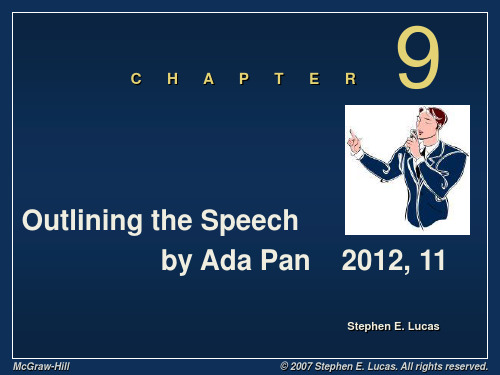
McGraw-Hill
© 2007 Stephen E. Lucas. All rights reserved.
Outlining Your Speech
Chapter 11
Outlining Your Speech
Chapter 11
Slide 15
Tips for Preparing the Speaking Outline
Slide 11
The Speaking Outline
The speaking outline:
a condensed form of the preparation outline used to help the speaker remember his or her ideas as they speak.
Title, specific purpose and thesis statement Introduction Main points, subpoints, and sub-subpoints Conclusion Connectives Works cited
Outlining Your Speech
• Follow the visual framework used in the preparation outline
• Keep the outline as brief as possible • Write clearly and legibly • Add cues for delivery
Chapter 11
Outlining Your Speech
Chapter 11
Outlining Your Speech
Chapter 11
THE ART OF PUBLIC SPEECH19页PPT
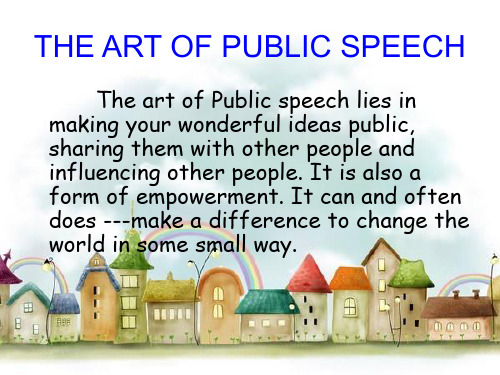
Syntactic description is based on the following elements: sentence types, sentence length, sentence complexity, clause types, phrase types, noun phrases, grammatical construction, word order, tenses, voices, etc.
normal Don’t think of yourself as having stage fright but
“stage excitement” Acquire speaking experience and get fully
prepared beforehand
The speaker’s voice
Glowing Language
• Textual feature
Narrative Descriptive Expositive Argumentative
Good delivery
1. Get rid of stage fright 2. The speaker’s voice 3. The speaker’s body 4. The speaker’s individual style
• Stress:refers to emphasis placed on words to indicate the importance of ideas expressed.
• Pauses: used to signal the end of a thought unit
The speaker’s body
the-art-of-public-speaking-Chapter-13-informatives
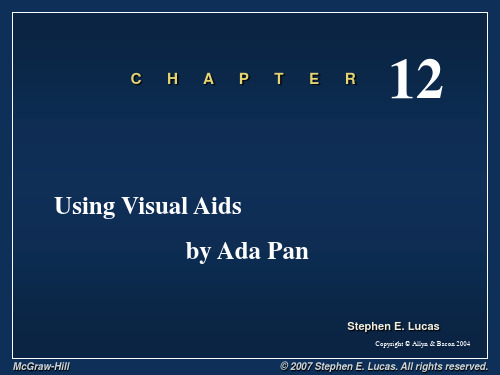
McGraw-Hill
© 2007 Stephen E. Lucas. All rights reserved.
13 C H A P T E R
Speaking to Inform by Ada Pan
McGraw-Hill
Stephen E. Lucas
Copyright © Allyn & Bacon 2004
•
to persuade my audience to do..
McGraw-Hill
© 2007 Stephen E. Lucas. All rights reserved.
Slide 14
SPEAKING TO INFORM
• 3 Criteria for Effective Informative Speaking:
Slide 18
•Speeche s About Objects
SPEAKING TO INFORM
–Describe something
• Visible
• Tangible
• In Stable Form
–Need to be Focused
McLGCrCaCw-EHNilGl 111
• Limited to one aspect of the object
Slide 17
SPEAKING TO
INFORM
•Speeches About:
–Objects –Processes –Events –Concepts
McLGCrCaCw-EHNilGl 111
KimAlyse Popkave, M.Ed., CMI, CPPC
Instructor © 2007 Stephen E. Lucas. All rights reser1v7ed.
The Art of Public Speaking
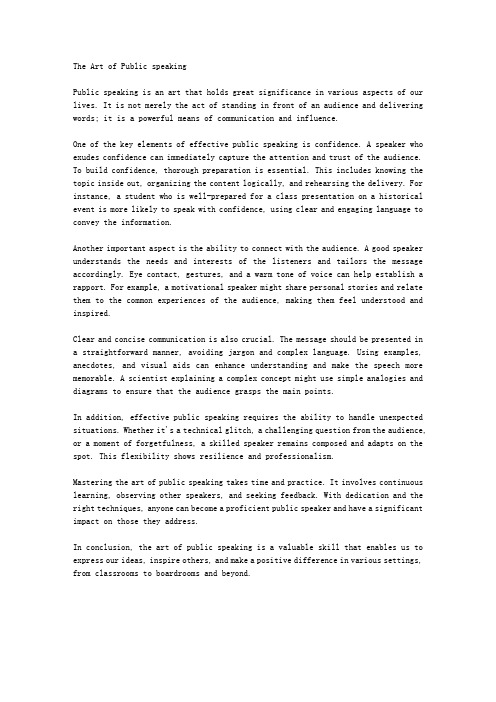
The Art of Public speakingPublic speaking is an art that holds great significance in various aspects of our lives. It is not merely the act of standing in front of an audience and delivering words; it is a powerful means of communication and influence.One of the key elements of effective public speaking is confidence. A speaker who exudes confidence can immediately capture the attention and trust of the audience. To build confidence, thorough preparation is essential. This includes knowing the topic inside out, organizing the content logically, and rehearsing the delivery. For instance, a student who is well-prepared for a class presentation on a historical event is more likely to speak with confidence, using clear and engaging language to convey the information.Another important aspect is the ability to connect with the audience. A good speaker understands the needs and interests of the listeners and tailors the message accordingly. Eye contact, gestures, and a warm tone of voice can help establish a rapport. For example, a motivational speaker might share personal stories and relate them to the common experiences of the audience, making them feel understood and inspired.Clear and concise communication is also crucial. The message should be presented in a straightforward manner, avoiding jargon and complex language. Using examples, anecdotes, and visual aids can enhance understanding and make the speech more memorable. A scientist explaining a complex concept might use simple analogies and diagrams to ensure that the audience grasps the main points.In addition, effective public speaking requires the ability to handle unexpected situations. Whether it's a technical glitch, a challenging question from the audience, or a moment of forgetfulness, a skilled speaker remains composed and adapts on the spot. This flexibility shows resilience and professionalism.Mastering the art of public speaking takes time and practice. It involves continuous learning, observing other speakers, and seeking feedback. With dedication and the right techniques, anyone can become a proficient public speaker and have a significant impact on those they address.In conclusion, the art of public speaking is a valuable skill that enables us to express our ideas, inspire others, and make a positive difference in various settings, from classrooms to boardrooms and beyond.。
- 1、下载文档前请自行甄别文档内容的完整性,平台不提供额外的编辑、内容补充、找答案等附加服务。
- 2、"仅部分预览"的文档,不可在线预览部分如存在完整性等问题,可反馈申请退款(可完整预览的文档不适用该条件!)。
- 3、如文档侵犯您的权益,请联系客服反馈,我们会尽快为您处理(人工客服工作时间:9:00-18:30)。
Fear of public speaking and fear of death rank #1 in most surveys asking people of their fear
14
Reducing Speech Anxiety
Acquire speaking experience Think positively Use the power of visualization Know that most nervousness is not
Organizing thoughts logically Tailoring the message to the
audience Telling a story for maximum impact Adapting to listener feedback
8
Differences Between Public Speaking and Conversation
Quintilian(昆提利安)(35-95 AD): was
interested in preparing orators who
spoke eloquently, exhibiting good
moral character and ethics
6
Modern famous speakers
Know your audience Select an appropriate topic Re-create the speech environment
when you rehearse Know your introduction and
conclusion Be organized Use visual aids
Franklin Roosevelt Martin Luther King Margaret Thatcher Nelson Mandela … etc. Video: Great moments from famous
speakers
7
Similarities Between Public Speaking and Conversation
2
According to Aristotle
Evidence in persuasive messages is most effective in the source’s
– ethos艺术作品中的客观因素: credibility – pathos激起怜悯的因素: emotional appeal – logos理念,理性: logical appeal
5
2 of the most notable rhetoricians of ancient Rome
Cicero(西塞罗)(106-432BC): believed that a well rounded education in the liberal arts would enable speakers to speak with knowledge and expressiveness
It is mostly internal. You will usually feel more nervous than you look. Or mental stress.
12
Important Understandings About Stage Fright
Anxiety can be useful. Your nervousness can create a heightened state of readiness, allowing you to perform better than you might otherwise.
10
What Cபைடு நூலகம்uses Stage Fright?
inadequate preparation fear of being judged unfamiliarity with the audience or the
environment lack of knowledge about public
speaking feelings of inadequacy fear of the unknown negative past experiences
11
Important Understandings About Stage Fright
It is normal. Almost everyone experiences some nervousness about speaking in some situations.
Public speaking is more highly structured
Public speaking requires more formal language
Public speaking requires a different method of delivery
9
Stage Fright
The-art-of-publicspeaking
Outline
What is public speaking? History of public speaking Stage fright 7 basic elements of communication
process Common structure of a speech Types of speeches Informative speech
It can be managed. While you may never eliminate the nervousness you feel, you can deal with it and deliver a successful speech in spite of it.
13
Reducing Speech Anxiety
